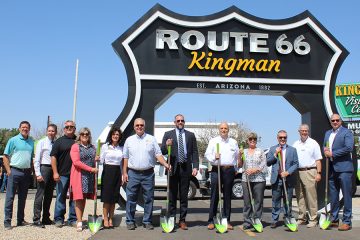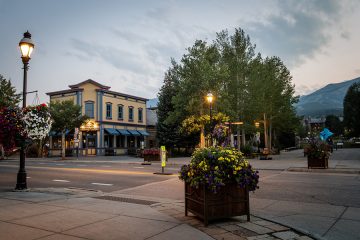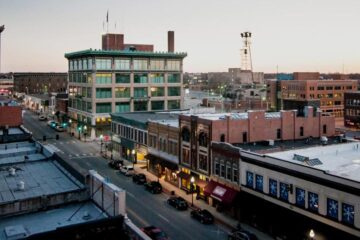- Residencial
- Negocio
-
- Ayuda
-
-
Streaming Class callout
Come to an ALLO Streaming Class!
We're offering free classes across many of our communities to help you learn what streaming is, how to get started, what equipment you need, and how to find the right streaming services for you.
Más InformaciónExplore Fiber link
-
- About
-
-
Featured job
ALLO has immediate openings for:
Bilingual Residential Customer Experience Specialist
Greeley, CO
We are looking for the kind of people who truly care, who work hard, and who are willing to step up for our customers and our fiber family. Variety is the spice of life on this team, so be ready to learn all of the ins and outs of ALLO, assume customer facing duties on and off the phones, and take on projects as needed.
Apply Today
-
¿Que esperar durante la construcción?
Queremos que este informado en cada paso del proceso. Mientras nuestro equipo construye la red de fibra óptica en su vecindario lo comunicaremos por correo, correo electrónico y carteles colgantes en sus puertas (entre muchas otras cosas) para mantenerlo informado. El mapa de su área en la página web siempre mostrará la información más actualizada sobre el progreso en su vecindario. Si tiene alguna inquietud durante el proceso de construcción, utilice el siguiente formulario de contacto.
ALLO actualmente está construyendo una red de fibra óptica para Google Fiber en Bellevue, Nebraska. Para preguntas relacionadas con la construcción o el servicio en Bellevue, Nebraska, favor de llamar al 877.454.6959 o visite https://google.com/fiber/yard. Todas las demás inquietudes pueden ser enviadas a través del siguiente formulario.
Proceso de Construcción
- 1 Diseño
- 2 CONSTRUCCIÓN
- 3 EMPALME/PRUEBAS
- 4 LISTO PARA INSTALAR
Antes de que escuche hablar de ALLO en su vecindario, estamos trabajando para diseñar las rutas de cable de fibra óptica en toda su comunidad.
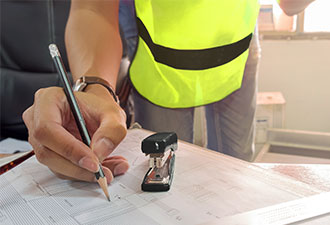
Los ingenieros deciden la forma más eficaz de llevar la fibra óptica al mayor número de personas en su zona.
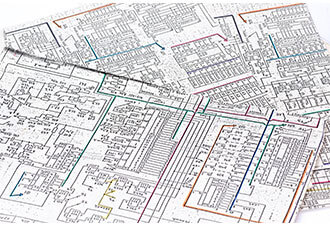
Los contratistas, funcionarios municipales y ALLO colaboran en el diseño de las rutas de cable y lo presentan a la ciudad para su aprobación.
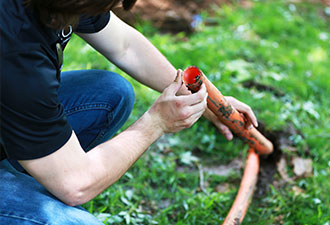
Una vez aprobado, ALLO trabaja con contratistas locales para empezar el proceso de construcción.
En un esfuerzo para proporcionar una notificación anticipada de la construcción, ALLO utilizará varias formas de comunicación tales como redes sociales, carteles de jardín, actualizaciones en la página web de ALLO, reuniones de asociaciones de vecinos, comunicación por correo o correo electrónico, y un aviso colocado directamente en la puerta de su casa.
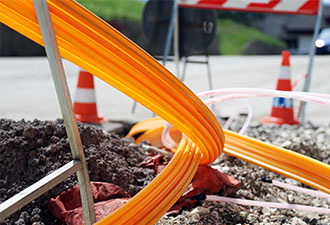
Las rutas principales de fibra óptica se construyen hasta los puntos de distribución ubicados a lo largo de la ciudad.
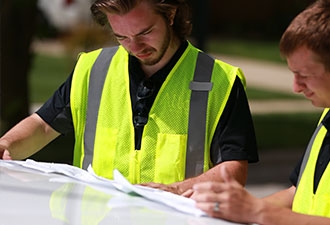
Los contratistas y empleados de servicios públicos llegan a su vecindario para marcar la ubicación de las líneas existentes en preparación para la construcción local.
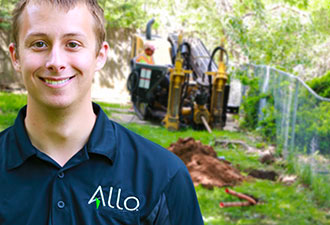
Construimos la ruta de fibra óptica desde los puntos de distribución directamente a las áreas de acceso de servicios públicos en su vecindario.
Nuestro equipo de construcción accede a cada bóveda de empalme y pedestal en toda la ciudad para fusionar las fibras individuales que eventualmente se conectarán a su hogar o negocio. Luego probamos la velocidad de la luz a medida que pasa a través de la fibra para asegurarnos de que su conexión sea tan rápida como un GIG.
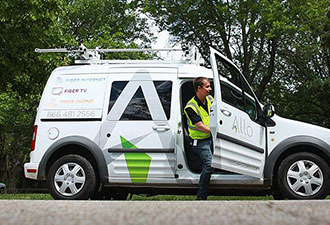
El equipo de ALLO estacionará una camioneta de construcción cerca de la bóveda de empalme en su vecindario para separar las fibras individuales que eventualmente se conectarán directamente a su hogar o negocio.
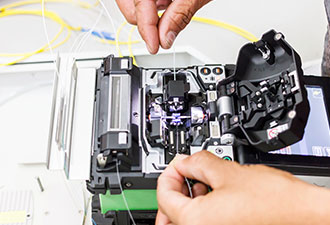
La fibra óptica se prueba para garantizar una ruta limpia y continua para que la luz viaje por ella.
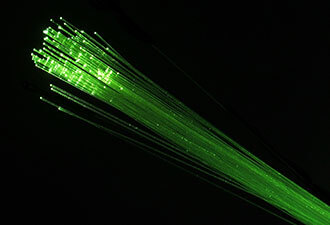
Cuando se completan el empalme y las pruebas, los cables son sellados en una caja de empalme hermética y enrollada hacia la bóveda de empalme, lista para ser accedida para instalaciones individuales.
Dos a cuatro días antes de la instalación, los técnicos llegaran para conectar la fibra óptica al costado de su hogar o negocio.
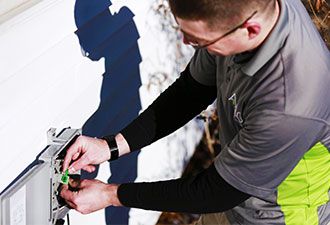
Dos días antes de la instalación, los técnicos llegaran para conectar la fibra óptica al costado de su hogar o negocio.
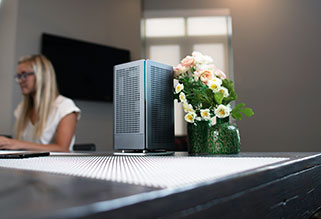
Su técnico de ALLO lleva una conexión de fibra óptica directa a su hogar o negocio y la conecta a nuestro router Blast Wi-Fi 6 (incluido).
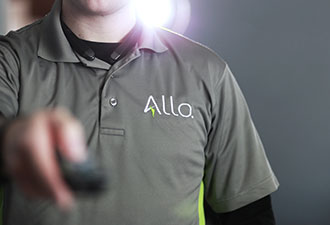
Probamos el alcance inalámbrico, le guiamos a través de nuestra guía rápida de TV, le ayudamos a configurar dispositivos adicionales, probamos su línea de teléfono y nos aseguramos de que esté completamente listo para disfrutar del futuro de la fibra óptica con ALLO.
Si está buscando información actualizada sobre su construcción, haga clic en el botón a continuación para seleccionar su área.
Selecciona tu ubicaciónPreguntas Frecuentes
Hay banderillas y gente en mi patio, ¿Qué están haciendo?
Las banderillas o marcadores en su área fueron puestas por las compañías de servicios públicos locales y ayudan a nuestro equipo a identificar dónde están las líneas subterráneas. Cuando ALLO empieza la construcción de fibra óptica, utilizamos estos marcadores para prevenir daños a su propiedad o utilidades. Consulte la lista a continuación para obtener una explicación de las asociaciones de colores de utilidad.
- Blanco: excavación propuesta.
- Rosa: marcas topográficas temporarias.
- Rojo: líneas de electricidad, cable, conductos y cables de iluminación.
- Amarillo: líneas de gas, petróleo, vapor, materiales petroleros o gaseosos.
- Naranja: líneas de comunicación, líneas de alarmas o señales, cables o conductos.
- Azul: líneas de agua potable.
- Morado: líneas de agua regenerada, de riego y lodo.
- Verde: líneas de alcantarillado y drenaje.
¿A qué profundidad tendrán que excavar para enterrar la línea de fibra óptica?
La línea principal en las servidumbres y los derechos de paso público está enterrada de entre dos a cuatro pies de profundidad y el cable de fibra óptica a la casa o al pedestal puede variar entre 8 a 12 pulgadas de profundidad.
Hay un agujero en mi patio rodeado por una cerca ¿Qué es eso?
Estamos colocando pedestales en la servidumbre de su patio. El pedestal, si el clima lo permite, se instalará poco después de que se prepare el terreno, por lo que se le coloca una cerca alrededor del agujero por razones de seguridad. El pedestal que finalmente se coloca aquí alberga el equipo para dar servicio a varios hogares y negocios de su zona. Nuestra intención es dejar la propiedad tal como la encontramos.
¿Qué es una “servidumbre” o “derecho de paso”?
La ciudad posee porciones pequeñas pero específicas de su propiedad para acceder y mantener los servicios públicos de la ciudad. Trabajamos con la ciudad para acceder estas áreas mientras construimos nuestra red de fibra óptica.
La servidumbre de servicios públicos le permite a un servicio público usar y acceder a un área específica de su propiedad para construir, operar y mantener las líneas de gas, electricidad, agua y alcantarillado. La servidumbre suele ser una restricción permanente en la propiedad, de manera que se transfiere junto con la casa o propiedad al venderla. Tener la servidumbre le da a la empresa de servicios públicos el derecho de usar el terreno, pero no es propietario de este.
Un “derecho de paso” es la superficie y el espacio superior e inferior de cualquier propiedad en la ciudad, en la que esta tiene un interés como dueño o administrador del público para transito general incluyendo calles públicas, carreteras, avenidas, caminos, callejones, servidumbres, aceras, túneles, viaductos o puentes.
¿Por qué hay un pedestal en mi patio y no en el patio de mi vecino?
Durante la etapa de diseño, el equipo de ingeniería determina la forma más eficiente de brindar servicio. Ellos seleccionan el punto de intersección posterior de la propiedad menos intrusivo como ubicación general para un pedestal que suele estar en el centro de las esquinas de cuatro propiedades. A partir de ese punto, la ubicación del pedestal se identifica cuidadosamente basada en los siguientes factores:
- Servicios subterráneos existentes.
- La ubicación del conducto subterráneo que alimentara el pedestal.
- La proximidad a otros pedestales.
- Características del paisaje y/u obstrucciones.
- Facilidad de acceso para los equipos de construcción y mantenimiento de la red.
¿Cuál es el estado del progreso de ALLO Fiber en mi vecindario?
La información actual del progreso de la red de fibra en su vecindario se encuentra en la página específica de su área.
Inquietudes sobre la construcción
Complete este formulario para comunicar inquietudes o quejas sobre la construcción a nuestro equipo. Si tiene preguntas sobre el progreso de la red de fibra en su vecindario, diríjase a la página específica de su área para información actual. Las solicitudes que no son de emergencia se manejarán dentro de cuatro días hábiles.
ALLO is currently constructing a fiber network for Google Fiber in Bellevue, NE. For construction or service-related questions in Bellevue, NE, please call 877-454-6959 o visite https://google.com/fiber/yard. All other ALLO construction concerns can be submitted on the form below.
Favor de llamarnos para situaciones que requieran atención inmediata:
Residencial: 866.481.2556
Negocios: 855.632.3154

